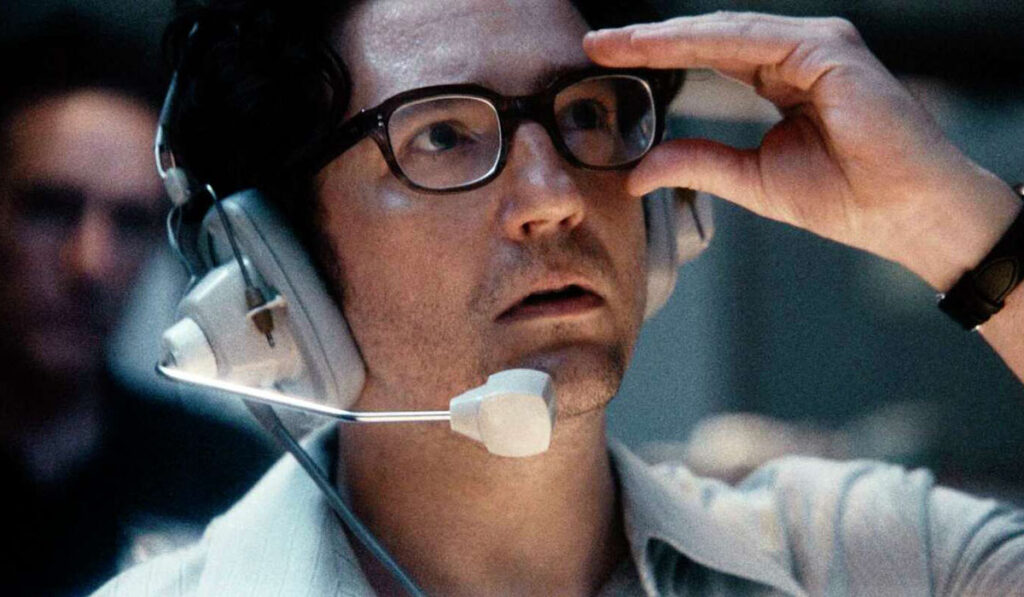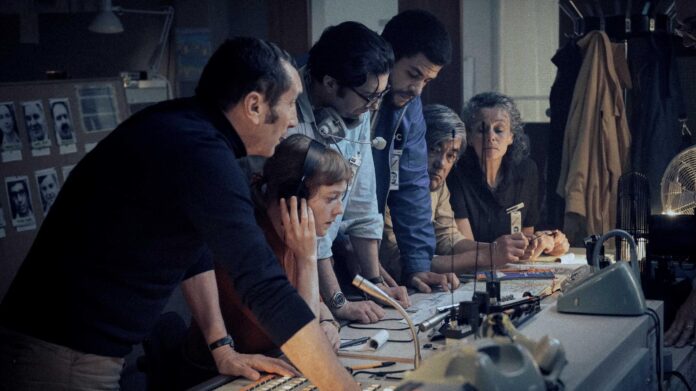ABC had a big hit on its hands, broadcasting the 1972 Summer Olympics in Munich, Germany. American swimmer Mark Spitz in his tiny, star-spangled Speedo, set world record after world record on his way to winning seven gold metals. Soviet gymnast Olga Korbut won the hearts of the West with her graceful performances. But then with 30-year-old neophyte producer Geoffrey Mason taking a shift turning the down hours of the games, the world shifted on its axis as a terrorist group called Black September took the entire Israeli team hostage.
In an era where films routinely push well past the two-hour mark, Swiss writer-director Tim Fehlbaum’s “September 5” relates the terrible events of that day in a scant 95 minutes. It is a streamlined running time full of suspense (despite the well-known outcome) and packed with detail. It is virtually three films in one. It limns the tragedy unfolding before ABC’s cameras while depicting how Mason (John Magaro), his boss Roone Arledge (Peter Sarsgaard), and their team managed the unprecedented by covering the event as it happened. It also offers near-documentary insights into the analog world of the 1970s.
Meeting the real Geoffrey Mason, who would go on to have a distinguished career as a sports production executive, winning 26 Emmys, was a key moment for Fehlbaum as he researched the story. Initially, he focused on the hostage crisis but the more he learned, the more he realized the role media played then and how that impacted media history. It was extraordinary, too, for a network sports department to pivot into delivering the news live for nearly an entire 24 hours.
“Mason says there’s no other day in his career that he remembers as vividly as this day,” Fehlbaum says during a visit to San Francisco with Magaro. “Listening to his stories of what they experienced, how, for example, the police came into the control room at a certain point, telling them to turn off the cameras. This is what sparked or made us confident of telling the story entirely from that angle.”
“He had a mission,” Magaro adds, remembering his own conversations with the man he would inhabit. “He wanted to do his job, and he wanted to do it well. They had a story to tell. There was no time to think. They didn’t really get to process until after the 22 hours and they went back to the hotel. Then that’s when the emotion hit.”
Magaro credits Mason not just with giving Fehlbaum and his co-writers the roots from which they could tell their story but for making it possible to tell it on a more practical level. It was Mason that got Fehlbaum and his cast into control rooms so they could learn the language of broadcasting and observes how sports and news programs are produced.
“It was very clear the first day we stepped into a broadcast room that if we didn’t get that right, we were doomed,” Magaro says. “I’ve learned instruments before in preparation for films, and that’s the closest parallel I can think of to this. It was like learning to play the piano or learning to play the drums. I found there’s a kind of musicality in the calling of a live broadcast, and it’s extremely specific. Anyone who’s been there and seen it would see through the false notes if we didn’t nail it”
Actors play all the roles in September 5, save one. With Mason’s help, Fehlbaum was able to secure the rights to use footage of broadcaster Jim McKay. The legendary Wide World of Sports host was anchoring the Olympics when he found himself reporting the news and it fell to him to relay the horrific end to the hostage situation to the television audience. It was the one role Fehlbaum did not want to fill with a performer.

“It’s very obvious when you see him, that to get the story right, you need him. That’s where I went when I saw the original footage,” the filmmaker says. “We can recreate all these moments in the Olympic village. We could recreate the control room. We could recreate everything. But what we could never recreate was that element, Jim McKay, and how he had this unique way of talking into the camera and guiding the viewer through this day. At a certain point, there was discussion of how can we recreate that with an actor? And I was saying, almost dramatically, ‘If you don’t get McKay, we don’t have to do the movie at all.’”
Adds Magaro, “For us as actors, it really made us step up our game and reach for as much honesty and authenticity as possible. Not only did we feel responsibility towards the events of that day and to the people who were in that room and to the victims and all of those things, but then we constantly had this reminder of Jim McKay on the screen, he was ever present. And in a lot of ways, he’s the best actor in the film, because he’s just Jim McKay. So, it made us have to really throw any false notes aside and just be as real as possible.”
Beyond the events he was recreating, Fehlbaum remains fascinated by the analog world of the era, one where a crew had to disguise himself as an athlete in order to sneak film into the locked-down Olympic village and photos obtained from an Olympics program of the Israeli athletes had to be re-photographed, developed, and enlarged in order to be able to broadcast them. The director admits it was the idea that Mason, Arledge, and their team were creating something brand new that day rather than the terrible history portrayed that ignited his imagination.
“It was the media perspective I found interesting,” he says. “Especially for today’s audience, in a world where everybody has a camera and a TV in their pocket, it seemed interesting to learn about that turning point in media history.”






